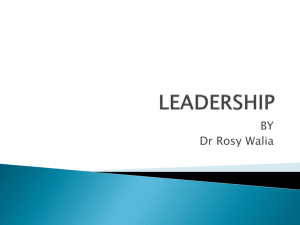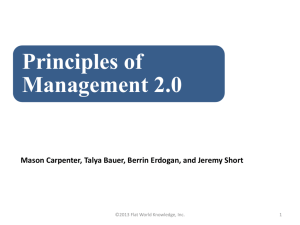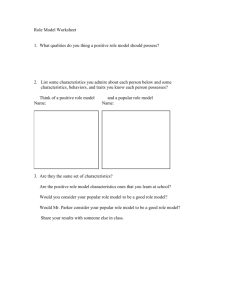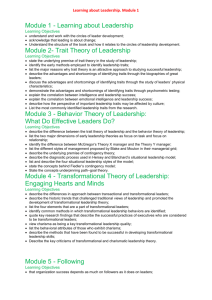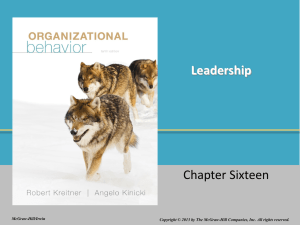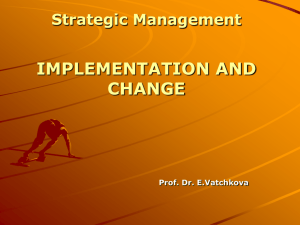Leadership
advertisement
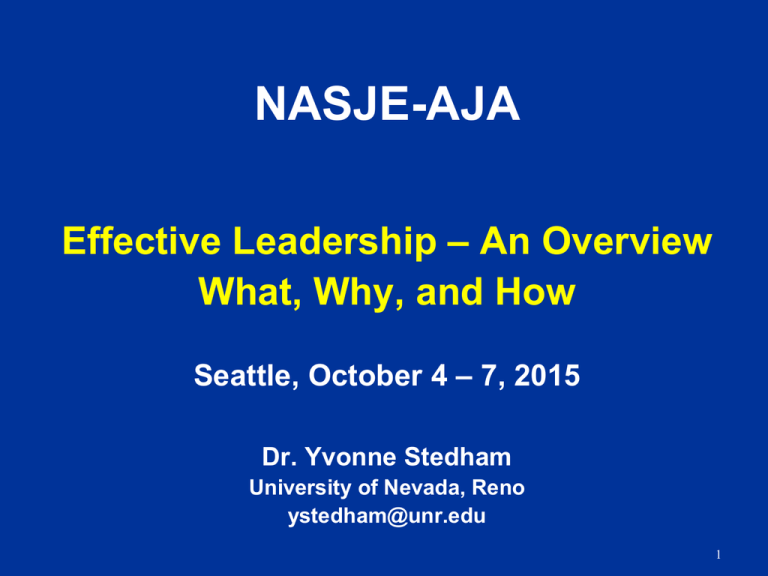
NASJE-AJA Effective Leadership – An Overview What, Why, and How Seattle, October 4 – 7, 2015 Dr. Yvonne Stedham University of Nevada, Reno ystedham@unr.edu 1 Why are we here … at this conference, in this session? 2 Speaker is here … Because I think about and know something about organizational effectiveness and efficiency, management, leadership, and quality of work life … in the Judiciary. Because I am an educator, and think, I know something about teaching and learning. 3 Audience is here … Because …… 4 NASJE The National Association of State Judicial Educators (NASJE) is a nonprofit organization, founded in 1975, that strives to improve the justice system through judicial branch education. 5 AJA The objective and purpose of the American Judges Association (AJA) is: to promote and improve the effective administration of justice; to maintain the status and independence of the judiciary; to provide a forum for the continuing education of its members and the general public; and for the exchange of new ideas among all judges. 6 Professional Development On NASJE Website – Featured News (9/16/15): Judicial educators create opportunities for transformative education that strengthens the administration of justice. One of the most important and valuable transformations we can facilitate is that from new hire to supervisor, manager, executive and beyond. 7 Transformative Education Transformational Learning (TL) is a learning experience that induces more far-reaching change in the learner than traditional contentbased education and especially those learning experiences which reshape the learner, provide a paradigm shift, and affect the learner’s subsequent experiences. In TL, the learner’s existing mental models are challenged, shifted, and, thereby, expose experiences to new interpretations which in turn leads to changed behaviors 8 Transformative Education TL requires the experience of a deep, structural shift in the learner’s basic premises of thought, feelings, and actions. It is a shift of consciousness that dramatically and irreversibly alters our way of being in the world A core aspect of TL is “to become aware of one’s own tacit assumptions and expectations and those of others and assessing their relevance for making an interpretation” Mezirow 9 Leadership Development and Transformational Learning Transformational Leadership (Today – In this Session) Developing Leadership Skills through Mindfulness • Mindful Leadership 10 Purpose, Topics, and Learning Objectives 11 Purpose To provide participants with an understanding of the need for leadership in the judiciary and to motivate and assist participants in developing their own leadership potential. And, a few words about “teaching” leadership! 12 Learning Objectives 1. Understand the need for leadership in organizations in general and in the judiciary in particular. 2. Know about different ideas of effective leadership. 3. Learn about transformational leadership and the associated leadership practices. 13 Topics 1. Leadership – WHY • Relevance • The Need for Leadership in the Judiciary 2. Leadership – WHAT • Describe, explain, demonstrate • Who would you “follow”? 3. Leadership – HOW • From Transaction to Transformation • The Leadership Practices 14 Leadership – WHY 15 Which of the following pictures …. …. appropriately represents the leader ??? 16 17 18 19 20 Leadership Why are we talking about leadership …. Leadership Leaders shape “how we live” Leadership and Change • Leaders identify the need for change, initiate and implement change Leadership in Organizations and the Judiciary Why do organizations exist? (private, public; for-profit, not-for-profit) Success of an organization? 23 Leadership in Organizations and the Judiciary Success of an organization • Efficiency • Effectiveness 24 Leadership in Organizations and the Judiciary How does an organization maintain its effectiveness over the long term? 25 The Organization Environment Organization Organization’s External Environment Political Strategic Management Economic Social SWOT Techno logical Environ mental Legal Mission Goals Objectives Organization’s Internal Environment People Structure Processes Culture External Environment PESTEL Factors Political Economic Social Technological Environment-Physical Legal 28 Internal Environment People Structure Processes Culture 29 Leadership in Organizations WHY? 30 Leadership – WHY? Organizations need to change over time to provide the products or services that society wants or needs efficiently and effectively 31 Need for Leadership in the Judiciary Examples Need for Change? Efficiency and Effectiveness • Tension • Ethical Dilemmas 32 Resistance to Change Why is it so difficult to create change? Why resistance to change? 33 Resistance to Change Uncertainty ….. Fear ….. • Can I perform in the changed environment? • Can I deliver the newly defined outcome? 34 35 Leadership – WHAT 36 Group Exercise What makes a person an effective leader?? Gather in groups of 4-5 – 5 minutes Based on your actual experience …… 1. 2. 3. Describe an effective leader? Traits? Skills? Behaviors? Based on your answer to Q #1, how do you “teach” someone to be an effective leader? Pick a spokesperson Typical Answers Behaviors Provides direction - vision Asks for input and participation - empowerment Treats people with respect and trust Walks the talk Traits and Skills Is honest and has integrity Is knowledgeable and has experience Good listener – communications skills 38 Influence and Power Five Bases of Power (French and Raven) 1. 2. 3. 4. 5. Legitimate Power Coercive Power Reward Power Expert Power Referent Power (Charisma) Position-based vs. Person-based Power 39 40 What People Value in Leaders Source: 88% Honest 71% Forward-looking 66% Competent 65% Inspiring 47% Intelligent 42% Fair-minded 40% Broad-minded 35% Supportive 34% Straightforward 33% Dependable The Leadership Challenge 28% Cooperative 24% Determined 23% Imaginative 21% Ambitious 20% Courageous 20% Caring 17% Mature 14% Loyal 8% Self-controlled 6% Independent 41 TRUST the willingness to be vulnerable 42 TRUST depends on • Perceiving someone as having ability (competent …) • Perceiving someone as having integrity (honesty …) • Perceiving someone as having benevolence (fair minded …) Creating Trust - Ability You will be more likely to follow someone who you perceive as competent, as someone who knows what they are talking about. How do you know whether someone is competent? • • • • Observations - past behavior Experience Training Conversations - relationship 44 Creating Trust - Integrity You will be more likely to follow someone who you perceive as having integrity. How do you know whether someone has integrity? • Tells the truth • Consistency in behaviors Words and actions Across different people • Observations - past behavior • Conversations - relationship 45 Creating Trust - Benevolence You will be more likely to follow someone who you perceive as being benevolent towards you – has your best interest in mind. How do you know whether someone is benevolent? • Cares about you • Knows what is important to you • Respects you 46 Leadership… …is a process whereby an individual influences a group of individuals to achieve a common goal. Trust … …is the foundation for effective leadership. 47 Leadership – HOW 48 Leadership Effectiveness? 1. 2. 3. 4. Leader Traits – Leaders are Born Leader Behaviors and Styles Situational Leadership Transformational - Leader Practices Relate to a person’s ability to identify, initiate, and implement change through influencing others. 49 Leadership Effectiveness? 1. Leader Traits • Traits • Personality • Emotional Intelligence 50 Leadership Failure Leaders failed because they were viewed as having the following traits • • • • intimidating, insensitive, abrasive cold, aloof, arrogant not trustworthy self-centered, overly ambitious Relate to TRUST 51 Leadership Effectiveness? 2. Leader Behavior and Styles • Job centered and employee centered styles 52 Leadership Effectiveness? 3. Situational Leadership • Define the “situation” – Commitment and ability of followers • Leader must be able to use different styles –Supportive and Directive • Match Situation and Style 53 Leadership Effectiveness? 4. Leader Practices • Transformational Leadership • The Leadership Challenge • Leadership Practices Inventory 54 Name the Following … First Question The two wealthiest people in the world Academy Awards – last two best movies, actors or actresses 55 Name the following … First Question The 2 wealthiest people in the world Academy Awards – Last two best movies, actors, or actresses Name the Following … The 2 wealthiest people in the world: Bill Gates, Carlos Slim, (Warren Buffet). Academy Awards – last best best pictures: 2014 Birdman; 2013 12 Years a Slave; (2012 Argo) Name the Following … Academy Award Best Actors: 2014 Eddie Redmayne – The Theory of Everything; 2013 Matthew McConaughey – Dallas Buyers Club; (2012 Daniel Day-Lewis – Lincoln) Name the Following … Academy Award Best Actress: 2014 Julianne Moore – Still Alice 2013 Cate Blanchett – Blue Jasmine (2012 Jennifer Lawrence – Silver Linings Playbook) Name the following … Second Question A teacher or coach who helped you through school Two friends who helped you through difficult times Name the following …. Which one of the two questions was easier to answer? 61 Name the following … The people who make a difference in our lives are not the ones who have the most credentials, the most money, most awards. They are the ones who care about us. It’s all about relationships 62 Therefore ….. Leadership is not about position or fame or fortune. Leadership is a relationship between those that aspire to lead and those who choose to follow. If we want to make a difference in the lives of others, those people have to see us as someone who can develop them. But to develop others, we have to develop ourselves The leader’s primary instrument is the self. 63 Transformational Leadership Linking roles of leadership and followership • Leaders are people who tap into the motives of followers in order to better reach the goals of leaders and followers • Different from power – inseparable from the followers’ needs 64 Leadership Theory Development Leader Traits Leader Behaviors and Styles Situational Leader Practices 65 Transactional Leader Traits Leader Behaviors and Styles Transformational Situational Leader Practices 66 Transactional Transformational Focus on Leader Focus on Follower Leader Traits Leader Behaviors and Styles Situational Leader Practices 67 The Leadership Challenge James Kouzes and Barry Posner https://www.youtube.com/watch?v=3cpLFFZsbWY&list =PLsRNoUx8w3rMHXNPgEJukmc9UZmLjRgkD 68 Developing Leadership Skills 69 Leadership Practices 1. 2. 3. 4. 5. Model the way Inspire a shared vision Challenge the Process Enable others to act Encourage the heart 70 Relevance The more frequently people engage in these practices, the more likely it is that they are effective as a leader 71 Leadership Practices Judicial context • Challenging the process? • Enable others to act? General • Most difficult – Inspiring a shared vision and Encouraging the heart • Not difficult – Model the way 72 Kouzes and Posner To lead, create a shared vision The best way to lead people in the future is to connect with them deeply in the present. The only visions that take hold are shared visions 73 Transactional Transformational Focus on Leader Focus on Follower Leader Traits Leader Behaviors and Styles Situational Leader Practices 74 Final Example Franklin Roosevelt 75 Session Summary 76 1. Leadership – WHY Need for change – Leaders identify the need for change, initiate, and implement change 2. Leadership – WHAT Influence others’ actions by creating relationships based on trust (perceived ability, integrity, and benevolence). 1. Leadership – HOW Using transformational leadership practices to create relationships based on trust - Modeling the way, Inspiring a shared vision, Challenging the process, Enabling others to 77 act, Encouraging the heart. Readings James Kouzes and Barry Posner (2012). “Leadership Challenge” James Kouzes and Barry Posner (2009). “To lead, create a shared vision.” Harvard Business Review, January: 20-21 Northouse (2007). “Leadership: Theory and practice” Robert Sutton (2007). “The No Asshole Rule” Mezirow (2000). “Learning as Transformation: Critical Perspectives on a Theory in Progress.”. Senge, Scharmer, Jaworski, Flowers (2005). “Presence: The Exploration of Profound Change in People, Organizations, and Society.” Go to the people, Learn from them, Live with them, Start with what they know, Build with what they have, The best leaders, When the job is done, When the task is accomplished, The people will say, We have done it ourselves Lao Tzu (600 B.C., China)

